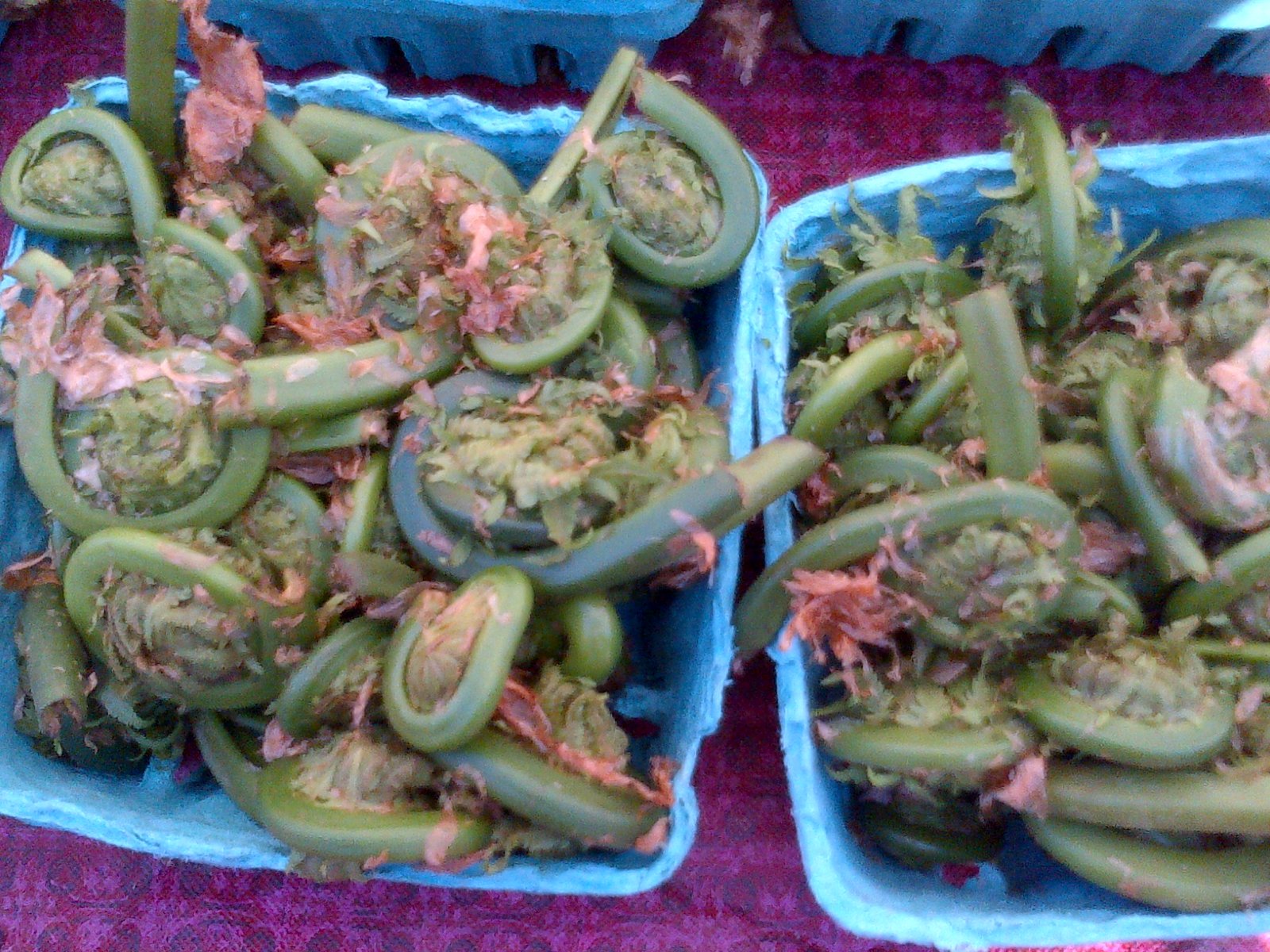With the Great Power of being a savant comes Great Responsibility. *
(* I just found out that Voltaire said this first, not Peter Parker's Uncle Ben! )
No longer can I pass by a cute little container of some springtime vegetable and think, Yeah, fiddleheads. Whatever.
Instead, I now think, Look at those veggies in those little boxes! Wow, it's probably been about 20 years since I tried them. Look at their tiny, ferny fronds! They look like the curled top of a violin - no wonder they're called fiddlehead ferns!
How do they taste? Will they be a burst of springtime goodness, or will I consign them to the unsung-for-a-good-reason produce pile?
 |
| Look at the tiny ferny fronds |
Perhaps inspired by the Market's signs for ramps, a fiddlehead announcement appeared. (Just the one, though.)
I saw no evidence of ramps-style mania, but the farmer of the sole booth that was selling fiddleheads was subtly persuasive. He told me that fiddleheads have an extremely short season - on his farm, just about 2 weeks. Like many of the Union Square farmers, he was a very effective produce proselytizer. I seized the moment and bought a box and brought them home.
En route I suddenly recalled reading somewhere that fiddleheads must be cooked thoroughly...because they're poisonous! Perhaps the sign's full message was, "Fiddleheads are here! Eat them, and you may not be!"
I headed to the computer. In Fine Gardening magazine, Ruth Lively, an editor of Kitchen Gardener magazine, had words praise ("Fiddleheads offer a fresh flavor reminiscent of asparagus and a pleasantly crunch, tender-firm texture") tempered by some cautionary advice:
Throughout the world, several types of fiddleheads are eaten, though most contain toxic compounds. The most commonly eaten and most esteemed fiddlehead is that of the ostrich fern, often simply called fiddlehead fern. The ostrich fern is the safest fern to eat, even though it, too, can contain toxins. The fiddleheads of cinnamon fern, lady fern, and bracken fern can also be eaten, but all are at least mildly toxic and can cause nausea, dizziness, and headache, so it’s probably best to avoid them. The safest way to eat fiddleheads is to stick to ostrich ferns and to eat them in small quantities.
Nausea, dizziness and headaches - bon appetit! That about ensured that I was unlikely to sample any quantity in excess of the contents of the little box in my hand.
The farmer had recommended steaming the fiddleheads for a few minutes then sauteing them, so I followed his suggestion. I opted not to dunk them in an ice bath between steaming and sauteing. I often say, "Eh" to blanching, admirable though it might be. Now that I knew the fiddleheads' toxic secret - unmentioned by the farmer - ganging up on them with two methods of cooking seemed wise.
I dumped the fiddleheads in a bowl of water and rubbed off the bits of dried brown skin.
Next was a few minutes in a steam bath.
 |
| I'm shvitzing! |
And then a few minutes in the cast iron skillet.
Fiddleheads are quick to cook, and striking to look at.
But what about the taste? They have their fans - one food blogger happily plunked down $19.99/lb at a West Coast gourmet market for his fiddleheads - but others are less enthusiastic about fiddleheads. In response to the query "What do fiddleheads taste like?" some suggested asparagus (albeit in a "weird, dirty way"), but others suggested "dirt" and "grass," and - in one memorable, Gee-how-would-they-have-this-reference-point? answer - "like boiled mouse."
The middle of the road may indeed be for yellow lines and dead armdillos, as noted activist Jim Hightower used to say, but in this case that's where my opinion ended up. (As an aside, I usually try to encourage vegetarianism through the preparation of delicious, meat-free meals, but all these mentions of dead and/or boiled varmints has me wondering if I have been subliminally trying a different route here - inspiring some visceral disgust. Sorry.)
To me, the fiddleheads tasted more like spinach than asparagus. They had a certain freshness that I could imagine would inspire some enthusiasm. I thought I detected a bit of cynarin, the acid in artichokes that makes food eaten thereafter taste sweeter, but my exhaustive research (i.e., a few minutes with my pal Google) didn't yield any connections.
The Verdict: Forced to pay a premium price for fiddleheads? Skip 'em. If they're growing wild in your backyard, I understand why the annual forage would be springtime delight. Except for the inevitable excessive consumption/ dizziness/ nausea/ headaches/ death thing.
And if you missed them, well, there's always next year.





It's like one big science experiment you had!
ReplyDeleteWe have the same plant here in Japan, called "Kogomi", and you know what? I just wash'n dump them into tempura batter and fry away! Maybe Japanese have antibodies for Fiddlehead toxins?